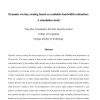Free Online Productivity Tools
i2Speak
i2Symbol
i2OCR
iTex2Img
iWeb2Print
iWeb2Shot
i2Type
iPdf2Split
iPdf2Merge
i2Bopomofo
i2Arabic
i2Style
i2Image
i2PDF
iLatex2Rtf
Sci2ools
104
click to vote
CN
2006
2006
Dynamic overlay routing based on available bandwidth estimation: A simulation study
Dynamic overlay routing has been proposed as a way to enhance the reliability and performance of IP networks. The major premise is that overlay routing can bypass congestion, transient outages, or suboptimal paths, by forwarding traffic through one or more intermediate overlay nodes. In this paper, we perform an extensive simulation study to investigate the performance of dynamic overlay routing. In particular, we leverage recent work on available bandwidth (avail-bw) estimation, and focus on overlay routing that selects paths based on avail-bw measurements between adjacent overlay nodes. First, we compare two overlay routing algorithms, reactive and proactive, with shortest-path native routing. We show that reactive routing has significant benefits in terms of throughput and path stability, while proactive routing is better in providing flows with a larger safety margin ("headroom"), and propose a hybrid routing scheme that combines the best features of the previous two alg...
Related Content
| Added | 11 Dec 2010 |
| Updated | 11 Dec 2010 |
| Type | Journal |
| Year | 2006 |
| Where | CN |
| Authors | Yong Zhu, Constantinos Dovrolis, Mostafa H. Ammar |
Comments (0)

